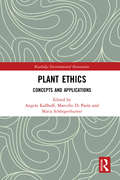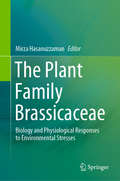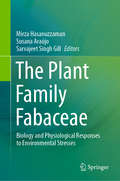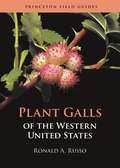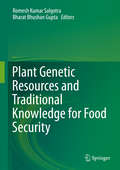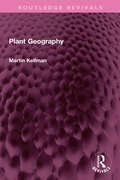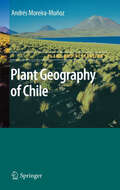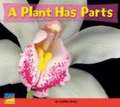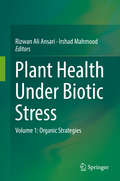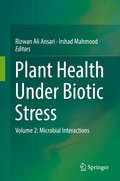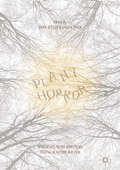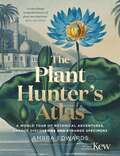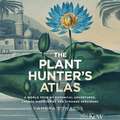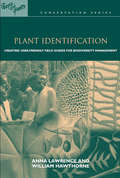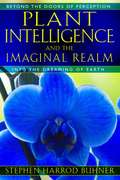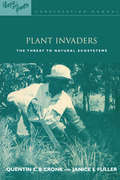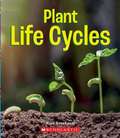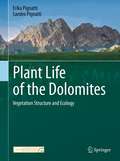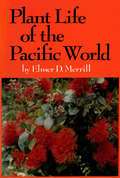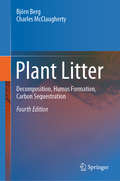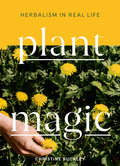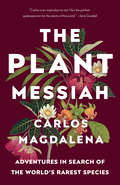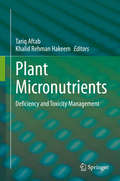- Table View
- List View
Plant Ethics: Concepts and Applications (Routledge Environmental Humanities)
by Angela Kallhoff, Marcello Di Paola and Maria SchörgenhumerLarge parts of our world are filled with plants, and human life depends on, interacts with, affects and is affected by plant life in various ways. Yet plants have not received nearly as much attention from philosophers and ethicists as they deserve. In environmental philosophy, plants are often swiftly subsumed under the categories of "all living things" and rarely considered thematically. There is a need for developing a more sophisticated theoretical understanding of plants and their practical role in human experience. Plant Ethics: Concepts and Applications aims at opening a philosophical discussion that may begin to fill that gap. The book investigates issues in plants ontology, ethics and the role of plants and their cultivation in various fields of application. It explores and develops important concepts to shape and frame plants-related philosophical questions accurately, including new ideas of how to address moral questions when confronted with plants in concrete scenarios. This edited volume brings together for the first time, and in an interdisciplinary spirit, contemporary approaches to plant ethics by international scholars of established reputation. It will be of great interest to students and scholars of Philosophy and Ethics.
The Plant Family Brassicaceae: Biology and Physiological Responses to Environmental Stresses
by Mirza HasanuzzamanThis book provides all aspects of the physiology, stress responses and tolerance to abiotic stresses of the Brassicaceae plants. Different plant families have been providing food, fodder, fuel, medicine and other basic needs for the human and animal since the ancient time. Among the plant families, Brassicaceae has special importance for their agri-horticultural importance and multifarious uses apart from the basic needs. Interest understanding the response of Brassicaceae plants toward abiotic stresses is growing considering the economic importance and the special adaptive mechanisms. The knowledge needs to be translated into improved elite lines that can contribute to achieve food security. The physiological and molecular mechanisms acting on Brassicaceae introduced in this book are useful to students and researchers working on biology, physiology, environmental interactions and biotechnology of Brassicaceae plants.
The Plant Family Fabaceae: Biology and Physiological Responses to Environmental Stresses
by Mirza Hasanuzzaman Susana Araújo Sarvajeet Singh GillThis book comprehensively introduces all aspects of the physiology, stress responses and tolerance to abiotic stresses of the Fabaceae plants. Different plant families have been providing food, fodder, fuel, medicine and other basic needs for the human and animal since the ancient time. Among the plant families Fabaceae have special importance for their agri-horticultural importance and multifarious uses apart from the basic needs. Interest in the response of Fabaceae plants toward abiotic stresses is growing considering the economic importance and the special adaptive mechanisms. Recent advances and developments in molecular and biotechnological tools has contributed to ease and wider this mission. This book provides up-to-date findings that will be of greater use for the students and researchers, particularly Plant Physiologists, Environmental Scientists, Biotechnologists, Botanists, Food Scientists and Agronomists, to get the information on the recent advances on this plant family in regard to physiology and stress tolerance.
Plant Galls of the Western United States (Princeton Field Guides #149)
by Ronald A. RussoA photographic guide to 536 species of plant galls found west of the RockiesBeautiful and bizarre, plant galls are growths of various shapes, sizes, and colors produced in response to invading organisms. Describing 536 species of galls and their causative agents, Plant Galls of the Western United States explores this unique realm with stunning photos and fascinating information about the life cycles of the organisms involved.Often species-specific, plant galls can be shaped like stars, baskets, clubs, wigs, bowls, and cups, with colors and combinations that stagger the imagination. This richly illustrated field guide examines how galls develop, and their uses, seasonal appearance and growth rate, predators, and defense mechanisms. The “architects” of galls—bacteria, fungi, mites, moths, beetles, flies, midges, and wasps—are explored in depth, and descriptions are paired with illustrations of these gall-inducing organisms and their typical galls. Gall accounts are divided into those that occur on trees, shrubs, and miscellaneous hosts, including native and ornamental plants. The guide contains a useful glossary and a bibliography.Features 536 gall species—including 120 new to science and 232 that have never appeared in a field guide beforeExamines for the first time more than 90 species from southwestern oak treesContains more than 150 species from most of the deserts of the western states
Plant Genetic Resources and Traditional Knowledge for Food Security
by Romesh Kumar Salgotra Bharat Bhushan GuptaWith exponentially increasing population across the globe and shrinking resources, the concern of food security is looming large over the world community. To catch up with the fierce pace of growth in all the sectors of development, ensuring uninhibited availability of food resources is a prime agenda. The growing global demand for food, feed, fiber and bio-based renewable materials, such as bio-fuels, is changing the conditions for genetic resources development and bio-resource production worldwide. The crucial role in ensuring food security is played by the agro-based industries and enterprises. Advances in plant genetic resources coupled with traditional knowledge of the local tribes and native practices facilitate achievement of food security.
Plant Geography (Routledge Revivals)
by Martin KellmanOriginally published in 1975 and in a second edition in 1980, Plant Geography was the first text in biogeography that provided an adequate treatment of modern plant population theory. It is an introduction to the subject for students of both geography and biology. The author develops a series of plant geographic concepts that are based primarily in plant population biology, treating in turn processes that operate at the level of the individual plant and the plant population; interactions between plant populations; environmental conditions and plant dissemination in shaping plant species’ distributions, and the geography of vegetation. Emphasis throughout is placed upon the dynamic nature of the earth’s plant cover, and the interplay between contemporary conditions and historical events in shaping plant distributions and evolution.
Plant Geography of Chile
by Andres Moreira-MunozThe first and so far only Plant Geography of Chile was written about 100 years ago, since when many things have changed: plants have been renamed and reclassified; taxonomy and systematics have experienced deep changes as have biology, geography, and biogeography. The time is therefore ripe for a new look at Chile's plants and their distribution. Focusing on three key issues - botany/systematics, geography and biogeographical analysis - this book presents a thoroughly updated synthesis both of Chilean plant geography and of the different approaches to studying it. Because of its range - from the neotropics to the temperate sub-Antarctic - Chile's flora provides a critical insight into evolutionary patterns, particularly in relation to the distribution along the latitudinal profiles and the global geographical relationships of the country's genera. The consequences of these relations for the evolution of the Chilean Flora are discussed. This book will provide a valuable resource for both graduate students and researchers in botany, plant taxonomy and systematics, biogeography, evolutionary biology and plant conservation.
Plant Health Under Biotic Stress: Volume 1: Organic Strategies
by Rizwan Ali Ansari Irshad MahmoodThe current scenario of increasing sensitivity towards the sustainable agriculture has given a large space to extensively utilize natural resources that are environmental friendly and are a good replacement of chemicals in agriculture. Application of organic additives in the sustainable disease management can provide new insight in sustenance of plant productivity along with improved host stress tolerance. In the present book we have focussed upon a range of organic strategies to control plant pathogens of wide spectrum in addition to maintaining robust plant health. A detailed account on the application of organic additives has been discussed, irrespective of their origin and nature. In addition, the methods of utilising these organic supplements in the management of plant diseases and promotion of plant yield in more economic way have also been presented with reference to developing, underdeveloped and developed countries. The book has included the works of eminent scholars from across the world thus flashing light on the key literature related to application of organic matters including phytoextracts, chopped leaves, composted organic manures and liquid manures in eco-friendly agriculture. The mechanisms underlying the effectiveness of these organic amendments in promoting plant health has also been presented and discussed in understandable ways.
Plant Health Under Biotic Stress: Volume 2: Microbial Interactions
by Rizwan Ali Ansari Irshad MahmoodThe book illustrates the use of putative microbial agents which provide good protection to the plant from biotic pathogens attack. An up to date knowledge on plant-microbiome interaction strategies in terms of improved sustainability has been discussed. Information from experts across the globe on the application of microbes for providing amicable solution in sustainable agriculture has been gathered. In addition, information related to microbes mediated resistance levels leading to enhanced plant health has been well presented. The chapters have emphasised the use of Plant Growth Promoting Rhizobacteria (PGPR) and other potential biocontrol agents/antagonists in the management of plant diseases which provide extensive information to the readers. Literature on microbial root colonization, plant growth promotions, and also on the protection of plants from attack of various soil borne pathogens have been presented in a coherent way. Information on the application of potential strain of the bio-control fungi, endophytes, actinomycetes strengthening the plants ability which rescue the plant from pathogens attack leading to improved plant health has also been underpinned.
Plant Horror
by Dawn Keetley Angela TengaThis collection explores artistic representations of vegetallife that imperil human life, voicing anxieties about our relationship to otherlife forms with which we share the earth. From medieval manuscriptillustrations to modern works of science fiction and horror, plants thatmanifest monstrous agency defy human control, challenge anthropocentricperception, and exact a violent vengeance for our blind and exploitativepractices. Plant Horror explores howdepictions of monster plants reveal concerns about the viability of ourprevailing belief systems and dominant ideologies-- as well as a deep-seatedfear about human vulnerability in an era of deepening ecological crisis. Filmsdiscussed include The Day of the Triffids, Invasion of the Body Snatchers, TheWicker Man, Swamp Thing, and The Happening.
The Plant-Hunter's Atlas: A World Tour of Botanical Adventures, Chance Discoveries and Strange Specimens
by Ambra Edwards'A refreshingly insightful history of plant introductions.' - Roy Lancaster Travel the world with extraordinary tales of the botanical discoveries that have shaped empires, built (and destroyed) economies, revolutionised medicine and advanced our understanding of science.Circling the globe from Australia's Botany Bay to the Tibetan plateau, from the deserts of Southern Africa to the jungles of Brazil, this book presents an incredible cast of characters - dedicated researchers and reckless adventurers, physicians, lovers and thieves. Meet dauntless Scots explorer David Douglas and visionary Prussian thinker Alexander von Humboldt, the 'Green Samurai' Mikinori Ogisu and the intrepid 17th century entomologist Maria Sibylla Merian - the first woman known to have made a living from science.Beautifully illustrated with over 100 botanical artworks from the archives of the Royal Botanic Gardens, Kew, this absorbing book tells the stories of how plants have travelled across the world - from the missions of the Pharaohs right up to 21st century seed-banks and the many new and endangered species being named every year.***THE ROYAL BOTANIC GARDENS, KEW is a world-famous research organisation and a major international visitor attraction. It harnesses the power of its science, the rich diversity of its gardens and collections to unearth why plants and fungi matter to everyone. Its aspiration is to end the extinction crisis and help create a world where nature and biodiversity are protected, valued and managed sustainably.
The Plant-Hunter's Atlas: A World Tour of Botanical Adventures, Chance Discoveries and Strange Specimens
by Ambra Edwards'A refreshingly insightful history of plant introductions.' - Roy Lancaster Travel the world with extraordinary tales of the botanical discoveries that have shaped empires, built (and destroyed) economies, revolutionised medicine and advanced our understanding of science.Circling the globe from Australia's Botany Bay to the Tibetan plateau, from the deserts of Southern Africa to the jungles of Brazil, this book presents an incredible cast of characters - dedicated researchers and reckless adventurers, physicians, lovers and thieves. Meet dauntless Scots explorer David Douglas and visionary Prussian thinker Alexander von Humboldt, the 'Green Samurai' Mikinori Ogisu and the intrepid 17th century entomologist Maria Sibylla Merian - the first woman known to have made a living from science.Beautifully illustrated with over 100 botanical artworks from the archives of the Royal Botanic Gardens, Kew, this absorbing book tells the stories of how plants have travelled across the world - from the missions of the Pharaohs right up to 21st century seed-banks and the many new and endangered species being named every year.***THE ROYAL BOTANIC GARDENS, KEW is a world-famous research organisation and a major international visitor attraction. It harnesses the power of its science, the rich diversity of its gardens and collections to unearth why plants and fungi matter to everyone. Its aspiration is to end the extinction crisis and help create a world where nature and biodiversity are protected, valued and managed sustainably.
The Plant-Hunter's Atlas: A World Tour of Botanical Adventures, Chance Discoveries and Strange Specimens
by Ambra EdwardsThe Plant Hunter's Atlas is a lavishly illustrated volume telling some of the most extraordinary tales of horticultural discovery and exploring the characters behind the stories. Taking in the world's inhabited continents and spanning the centuries, the stories range from tales of derring-do in the age of discovery to modern-day botanists working at the cutting-edge of science. The text explores how plant hunters have been inspired by everything from scientific curiosity to economic greed, and their own ingrained sense of adventure. Each entry is illustrated with botanical artwork from the Royal Botanical Gardens, Kew's unrivalled collection of historical illustrations. Among the plant hunters included are: Sir Joseph Banks, Charles Darwin, David Douglas, Reginald Farrer, George Forrest, Robert Fortune, Tadeáš Haenke, Tom Hart Dyke, Alexander von Humboldt, the Lobb brothers, John Sibthorp and Ernest Henry Wilson.(P)2021 Quercus Editions Limited
Plant Identification: Creating User-Friendly Field Guides for Biodiversity Management
by Anna Lawrence William HawthorneAn important prerequisite for successful conservation is a good understanding of what we seek to conserve. Nowhere is this more the case than in the fight to protect plant biodiversity, which is threatened by human activity in many regions worldwide. This book is written in the belief that tools that enable more people to understand biodiversity can not only aid protection efforts but also contribute to rural livelihoods. Among the most important of those tools is the field guide. Plant Identification provides potential authors of field guides with practical advice about all aspects of producing user-friendly guides which help to identify plants for the purposes of conservation, sustainable use, participatory monitoring or greater appreciation of biodiversity. The book draws on both scientific and participatory processes, supported by the experience of contributors from across the tropics. It presents a core process for producing a field guide, setting out key steps, options and techniques available to the authors of a guide and, through illustration, helps authors choose methods and media appropriate to their context.
Plant Intelligence and the Imaginal Realm: Beyond the Doors of Perception into the Dreaming of Earth
by Stephen Harrod BuhnerA manual for opening the doors of perception and directly engaging the intelligence of the Natural World • Provides exercises to directly perceive and interact with the complex, living, self-organizing being that is Gaia • Reveals that every life form on Earth is highly intelligent and communicative • Examines the ecological function of invasive plants, bacterial resistance to antibiotics, psychotropic plants and fungi, and the human species In Plant Intelligence and the Imaginal Realm, Stephen Harrod Buhner reveals that all life forms on Earth possess intelligence, language, a sense of I and not I, and the capacity to dream. He shows that by consciously opening the doors of perception, we can reconnect with the living intelligences in Nature as kindred beings, become again wild scientists, nondomesticated explorers of a Gaian world just as Goethe, Barbara McClintock, James Lovelock, and others have done. For as Einstein commented, “We cannot solve the problems facing us by using the same kind of thinking that created them.” Buhner explains how to use analogical thinking and imaginal perception to directly experience the inherent meanings that flow through the world, that are expressed from each living form that surrounds us, and to directly initiate communication in return. He delves deeply into the ecological function of invasive plants, bacterial resistance to antibiotics, psychotropic plants and fungi, and, most importantly, the human species itself. He shows that human beings are not a plague on the planet, they have a specific ecological function as important to Gaia as that of plants and bacteria. Buhner shows that the capacity for depth connection and meaning-filled communication with the living world is inherent in every human being. It is as natural as breathing, as the beating of our own hearts, as our own desire for intimacy and love. We can change how we think and in so doing begin to address the difficulties of our times.
Plant Invaders: The Threat to Natural Ecosystems (People and Plants International Conservation #Vol. 1)
by Quentin C.B. Cronk Janice L. FullerA practical guide to the protection and management of ecosystems against invasions by non-indigenous plant species. The authors seek to offer an accessible account of the subject and how to protect natural habitats. The majority of countries suffer from invasive plants and there are case studies from North America, Europe, Australia, South and South East Asia and the Pacific and Atlantic islands. There is also a list of invasive species, with their countries of origin and regions of introduction.
Plant Life Cycles (A True Book)
by Mara GrunbaumIncredible Plants series introduces young investigative readers to many types of unusual and typical plants from photosynthesis, how they grow, and ways they survive in extreme environments.
Plant Life of the Dolomites
by Sandro Pignatti Erika PignattiThis volume provides an in-depth analysis of over 100 plant communities of the Dolomite vegetation. The data is based on the phytosociological relevés, which have been collected by the authors in nearly 2000 surveys. The key part consists of approx. 130 association tables presenting plant sociological data for the respective plant communities. Thus, this volume perfectly complements the successful main volume "Plant Life of the Dolomites: Vegetation Structure and Ecology," which features summarized, synoptic association tables of the twelve habitats. In addition, geo-referenced locations of relevés and detailed ecological measures are provided. A further part describes the individual components of the fascinating dolomitic landscape (Heritage of all Humanity) and presents tables of vegetation complexes, which summarize the more than 400 surveys carried out in the Dolomites. The structure of this supplementary volume corresponds to that of the main volume with a key part consisting of twelve chapters, each describing a specific habitat, and a total of 106 associations. Several topics covered in the main volume, such as the exploration of the flora, ecological factors and syntaxonomy are discussed further here.
Plant Life of the Pacific World
by Elmer D. MerrillThis Asian ecology book offers an overview of the plant life of the vast Pacific region.Among the topics covered are the tropical forest and jungles, the grasslands, the primary and secondary forest, and the plants of the seashores. <P><P>Weeds and cultivated plants are also discussed with overviews of plant distribution and notes on specific islands and island groups.Plant Life of the Pacific World will fill a great need as an important reference source not only for the ethnobotanist but for the professional botanist and the student interested in the flora of the Pacific basin. The information it contains-adequately detailed and clearly presented-should also open the eyes of both visitors and inhabitants to the natural riches of the Pacific region.
Plant Litter: Decomposition, Humus Formation, Carbon Sequestration
by Björn Berg Charles McClaughertyThis book gives basic facts about litter decomposition studies, which are of guidance for scientists who start studies. Since the publication of the third edition, there has been quite a development not only in the field of litter decomposition but also in supporting branches of science, which are important for fruitful work on and understanding of decomposition of plant litter and sequestration of carbon. A consequence is that ‘old established truths’ are becoming outdated. New knowledge in the fields of phytochemistry and microbial ecology has given a new baseline for discussing the concepts ‘litter decomposition’ and ‘carbon sequestration’. We can also see a rich literature on litter decomposition studies using roots and wood as substrates. These have given new insights in factors that regulate the decomposition rate and as regards roots their contribution to sequestered carbon in humus. Additional facts on the role of temperature vs the litters’ chemical composition may in part change our view on effects of climate change. Further information on applications of the new analytical technique (13C-NMR) for determining organic-chemical compounds has allowed us to develop these parts. Focus is laid on needle litter of Scots pine as a model substrate as this species has been considerably more studied than other litter species. Also the boreal/northern temperate coniferous forest has in part been given this role. Still, new information may allow us to develop information about litter from further tree species.
Plant Magic: Herbalism in Real Life
by Christine BuckleyA fun, modern, and irreverent introduction to healing herbs, this field guide to feeling good includes more than 20 plant profiles.Here is an invitation to the wild world of healing plants growing right outside your door. Highlighting herbs from catnip and plantain to nettles and rosemary, this book provides the information you need to assemble an herbal arsenal for combatting any ailment—everything from brewing up a slick lube tea for sexual health to fashioning a simple summer band-aid from backyard &“weeds&” to crafting an herbal smoking blend to quiet a busy mind. This accessible guide covers questions like: What is plant medicine? What can I put in my mouth and where do I find it? Can I still go to my doctor? We&’ve got you covered.
Plant Man: The Life and Art of Makoto Azuma (Fountas & Pinnell Classroom, Guided Reading Grade 6)
by Nicole WalkerFrom Guitars to FLOWERS When a young rock musician struggled to pay his bills, he was forced to take a job doing something he never thought he'd do: work in a flower shop. But that fateful turn of events changed Makoto Azuma's life forever. His job soon evolved into a passion for transforming flowers into art. Now, his amazing and outrageous artwork never fails to surprise and delight audiences around the world. NIMAC-sourced textbook
The Plant Messiah: Adventures in Search of the World's Rarest Species
by Carlos MagdalenaAn impassioned memoir of saving extraordinary plants on the brink of extinction, by a scientist who has been called a "codebreaker" (Telegraph) and "an inspiration" (Jane Goodall)Carlos Magdalena is not your average horticulturist. He's a man on a mission to save the world's most endangered plants. First captivated by the flora of his native Spain, he has travelled to the remotest parts of the globe in search of exotic species. Renowned for his pioneering work, he has committed his life to protecting plants from man-made ecological destruction and thieves hunting for wealthy collectors.In The Plant Messiah, Magdalena takes readers from the Amazon to the jungles of Mauritius to deep within the Australian Outback in search of the rare and the vulnerable. Back in the lab, we watch as he develops groundbreaking, left-field techniques for rescuing species from extinction, encouraging them to propagate and thrive once again. Along the way, he offers moving, heartfelt stories about the secrets contained within these incredible organisms. Passionate and absorbing, The Plant Messiah is a tribute to the diversity of life on our planet, and the importance of preserving it.*Featuring 16 pages of color photos*
Plant Micronutrients: Deficiency and Toxicity Management
by Khalid Rehman Hakeem Tariq AftabPlants require essential nutrients (macronutrients and micronutrients) for normal functioning. Sufficiency range is the levels of nutrients necessary to meet the plant’s needs for optimal growth. This range depends on individual plant species and the particular nutrient. Nutrient levels outside of a plant’s sufficiency range cause overall crop growth and health to decline, due either to deficiency or toxicity from over-accumulation. Apart from micronutrients (B, Cl, Mn, Fe, Zn, Cu and Mo), Aluminum (Al), cerium (Ce), cobalt (Co), iodine (I), lanthanum (La), sodium (Na), selenium (Se), silicon (Si), titanium (Ti), and vanadium (V) are emerging as novel biostimulants that may enhance crop productivity and nutritional quality. These beneficial elements are not "essential" but when supplied at low dosages, they augment plant growth, development, and yield by stimulating specific molecular, biochemical, and physiological pathways in responses to challenging environments.The book is the first reference volume that approaches plant micronutrient management with the latest biotechnological and omics tools. Expertly curated chapters highlight working solutions as well as open problems and future challenges in plant micronutrient deficiency or toxicity. We believe this book will introduce readers to state-of-the-art developments and research trends in this field.
